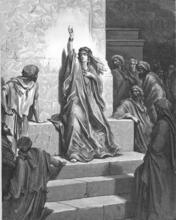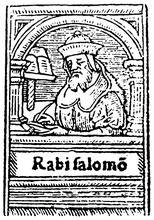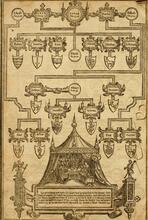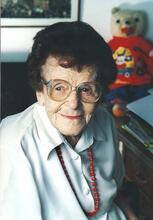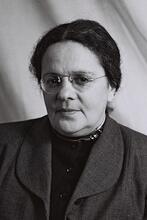Leadership and Authority
In biblical times, all Jewish leaders were elected by God. Although God’s directives, miracles, and promises were most often transmitted to men, women’s lives form the backdrop for many biblical lessons. Though women were a minority of the biblical leaders, they had a significant impact. Esteemed Jewish thinkers like Maimonides declared women as unfit to be leaders, despite the fact that the rabbis of the Talmud do not rebuke Deborah for judging nor criticize any of the queens for ruling. In the contemporary period, feminist theologians have re-examined the claim that women did not hold positions of authority. Today, Jewish women leaders hold positions of power and influence in countless areas and industries.
Ancient Leadership
All early biblical leaders of the Jewish people were elected by God. The matriarchs and patriarchs, priests, prophets, kings, judges, and warriors were chosen by divine plan to lead the nation at different points in its history. The Torah she-bi-khetav: Lit. "the written Torah." The Bible; the Pentateuch; Tanakh (the Pentateuch, Prophets and Hagiographia)Torah offers us glimpses into the relationships between Sarah and Abraham, Rebecca and Isaac, Rachel, Leah and Jacob, based on the principle that ma’aseh avot siman le-banim (the deeds of the ancestors serve as a model for the descendants). Beyond the biblical text, the influence of matriarchal faith and insight is conveyed in the midrashic literature, which expands the role of wife, helper, and mother to include prophetess, teacher and visionary. Yet it is clear from the biblical narrative that females did not serve in the broader leadership roles filled by males.
God’s directives, miracles, and promises are most often transmitted to men, while women’s lives form the backdrop for many biblical lessons. We learn the power of truth from Tamar (Genesis 38), the need for courage in the face of persecution from Jochebed (Exodus 2), the wisdom of timing from Zipporah (Exodus 4), the beauty of song and dance from Miriam (Exodus 15), and the pursuit of justice from the Daughters of Zelophehad (Numbers 27). These women serve as prototypes of piety and sacrifice, taking risks to be independent, yet never straying too far from the community. Although they are not all labeled as leaders per se, their examples have led and inspired Jews for generations.
The Lit. "teaching," "study," or "learning." A compilation of the commentary and discussions of the amora'im on the Mishnah. When not specified, "Talmud" refers to the Babylonian Talmud.Talmud (Lit. "scroll." Designation of the five scrolls of the Bible (Ruth, Song of Songs, Lamentations, Ecclesiastes, Esther). The Scroll of Esther is read on Purim from a parchment scroll.Megillah 14a) states that there were forty-eight prophets and seven prophetesses who prophesied to the people of Israel. Of the seven—Sarah, Miriam, Deborah, Hannah, Abigail, Huldah and Esther—three are actually referred to as nevi’ot (prophetesses) in the biblical text itself. Esther also served as queen when she was chosen by King Ahasuerus, although her rule was outside Israel. Three other women reigned as monarchs in the Land of Israel: Athaliah ruled the kingdom of Judea for seven years (2 Kings 11:4), Shelomziyyon Alexandra continued to rule Judea for nine years after the death of her husband King Alexander Yannai (Berakhot 48a), and Jezebel ruled as the evil and idolatrous wife of King Ahab, who himself “did more to anger God than any of the Kings of Israel before him” (1 Kings 16:33). There was also Queen Helene, the ruler of Adiabene who converted to Judaism, took a Nazirite vow and settled in Israel (M. Nazirite; person who vows to abstain for a specific period (or for life) from grape and grape products, cutting his hair, and touching a corpse.Nazir 3:6). The sources mention the existence of Gentile queens such as the Queen of Sheba, Semiramis of Babylon (wife of King Nebuchadnezzar) and Vashti (wife of King Ahasuerus).
Ancient Jewish leaders display strengths and weaknesses, respond swiftly, express deep emotions, and even err in judgment, yet ultimately they exemplify unswerving belief in God and humanity. They lead their families, their towns, their tribes, and even the nation as part of their mission or destiny. Most of the early leaders were adept at multiple tasks: Abraham served as sage, performing acts of hesed (kindness) and converting the masses, knowing when to make treaties and when to wage war. Deborah was a judge, a prophetess, a warrior and a poet. The roles of leadership, authority, power and influence usually overlapped.
Qualities of Leadership
Although early Jewish leaders simultaneously performed several tasks, Moses remains the unequalled model of a supreme leader. Due to his special relationship with God, his wisdom, courage, passion, and great humility, he epitomized the qualities of leadership as did no one who preceded or succeeded him. Yet it is Moses himself (at the suggestion of his father-in-law) who instituted a division of labor among the elders of the tribes. He sought to appoint men of strength, who feared God, who had integrity and abhorred profit (Exodus 18:21), who were also wise, insightful, and known to the people (Deut.1:13). This list of attributes became the checklist of essential qualities necessary for the appointment of judges and kings. The Talmud (Sanhedrin 17a) adds that stature, age, appearance, and fluency in many languages were also prerequisites to serve on the high court and Moses ben Maimon (Rambam), b. Spain, 1138Maimonides requires that such judges should also be knowledgeable in mathematics, medicine, astronomy, and sorcery. The Divine Presence (Shekhinah) rests on those who are brave, wealthy, wise, and humble, and all these traits are learned from Moses (Nedarim 38a).
Leaders were supposed to treat fellow Jews with patience and compassion, yet be willing to rebuke them. They had especially to be on their guard against arrogance and false pride. They had to worry about their reputation and how things were perceived by the people (Berakhot 43b). The ultimate leadership crime was the desecration of God’s name (hillul ha-Shem), and a leader had to have the ability to repent and self-correct. Leaders were also held accountable for the sins of the people if they failed to instruct the nation properly. Above all, Maimonides ruled that even a person of great wisdom could not hold a leadership position if he did not fear Heaven.
With the exception of the monarch, no single leader was expected to combine Torah scholarship, military prowess, legislative acumen, and popular appeal. While figures of authority throughout Jewish history exhibited a wide range of personalities, all leaders were supposed to be God-fearing and righteous. Judges had to keep their distance from the people, yet be accepted by them. Prophets had to be articulate but were often scorned and ignored by the populace. Men dominated such public positions, while women who performed similar tasks tended to remain in the shadows, working “under the palm tree” (like Deborah) or “speaking quietly to their hearts” (like Hannah).
Gender Roles
The Torah’s commandment to “appoint yourself a king” (Deut. 17:15) became codified into a law that limited the role to a king and not a queen (Sifrei 157). Maimonides took the ruling further, stating that only males could be appointed to positions of public authority (Melakhim 1:5), and R. Joseph Caro (1488–1575) declared that women were unfit to judge (Hoshen Mishpat 7:4). These statements became normative The legal corpus of Jewish laws and observances as prescribed in the Torah and interpreted by rabbinic authorities, beginning with those of the Mishnah and Talmud.halakhic practice, despite the fact that the rabbis of the Talmud do not rebuke Deborah for judging nor criticize any of the queens for ruling.
Other codifiers took issue with Maimonides’s sweeping exclusion and focused on an exegetical understanding of the text: you may not appoint women, but women could inherit the position (from mother to daughter or husband to wife). Furthermore, since all leadership positions depend on acceptance by the people, if the nation wants a woman, then the will of the people takes priority. The A type of non-halakhic literary activitiy of the Rabbis for interpreting non-legal material according to special principles of interpretation (hermeneutical rules).midrash makes mention of the existence of female judges, and the rabbinic literature is far from unanimous on the subject. Often, the halakhic discourse refers to other issues, such as modesty, sexuality, frivolity, and women’s belonging in private rather than public space, as social concerns that impact female leadership.
“All the honor of the king’s daughter is within” (Psalms 45:14) was applied by the rabbis to explain the different natures of men and women. Men belonged in the marketplace; women were needed at home. Family was highly valued and life at home was mostly in mixed company, but much of communal life and most of the ritual observance were divided by gender. Men led the prayers, codified legal decisions, controlled the community chest, and dealt with the outside world. This impacted women’s sphere of influence, which tended to be in the private domain. Exceptions to this rule are mentioned throughout the Talmud: Beruryah (wife of R. Meir) and Imma Shalom (wife of R. Eliezer) were scholars in their own right whose interpretations are quoted, while the wife of Jonah the prophet went up to Jerusalem for the three festivals and Michal, daughter of King Saul, donned Phylacteriestefillin.
Incidents involving certain “wise women” are mentioned in the books of the prophets. Both Elijah and Elisha performed miracles of life benefiting kind women who fed them, and several female members of the monarchy, such as Bathsheba (mother of King Solomon), are given credit for acts of courage and vision that changed the course of Jewish history. Hannah (mother of Samuel) formulated the structure and style for much of how we pray today, the Daughter of Jephthah the warrior led women to the mountains for two months “to lament her maidenhood” (Judges 11:38) and the Apocryphal Judith used brains, beauty, and bravery to kill Holofernes.
Feminist scholars and theologians have spent the last decades re-examining the archeological and cultural data upon which traditional historians claim that women were only granted honorary titles or had access to the community via their husbands or fathers. There were wealthy women in ancient Israel who were recognized as donors for contributing charity to synagogues and houses of learning, but it is not clear whether such figures actually wielded any authority. Inscriptions found on tombs and in excavations from ancient synagogues in Israel, Egypt, Syria, and Greece describe women as “patron,” “elder,” “head of the synagogue” and “mother of the synagogue.” Bernadette Brooten and others have challenged the view that these titles were purely “honorific,” bringing evidence that such positions could have offered women limited influence and power. Such theories are difficult to prove, particularly in a patriarchal legal system, but they do offer a more balanced view of how women authority models might have functioned. Female leadership can be found in the extraordinary behavior attributed to individual women who set a precedent, broke with convention, or defied established boundaries.
Feminist research has also focused on the different ways in which women bond, network, and solve problems. Women seem to display greater sensitivity to the group, more patience, deeper intuition, and innate empathy. Men appear to be more assertive, spontaneous, focused, and goal-oriented. Such generalizations accord with the rabbinic statement that “it is the nature of men to conquer; it is not the nature of women to conquer” (Yevamot 65b). Yet it remains unclear whether contrasting approaches to leadership are related to gender, personality, or environment. Jewish texts seem to support the view that personal style, regardless of gender, is the key to leadership strategy. Both Sarah and Abraham laughed at God’s promise; both Rachel and Jacob were involved in separate incidents of deception; both Miriam and Aaron complained about Moses. Ruth’s faith was as profound as that of Jethro generations earlier and the slaughter of Sisera by Jael (Judges 4) was as bold and bloody as Ehud’s murder of Eglon, King of Moab (Judges 3). Based on written documentation and in the social context of earlier generations, we still find fewer women than men who have been granted public positions of authority and power throughout Jewish history.
Modern Leadership
The concept of leadership training has evolved into a full field of study, with extensive research in theory and methodology. Current ideology continues to wrestle with the oft-quoted axiom that leaders are born, not made, by attempting to teach empathy, ethics, insight, and humor. Jewish sources acknowledge that certain leaders may be endowed with natural gifts such as charisma, charm, and compassion, but firmly believe that leadership skills can be taught. Judges were rigorously prepared for office, priests were meticulously trained for the Temple service, prophets were schooled in oration, and scholars studied for years to sharpen their analytic skills. Only then could they qualify to act as heads of the community.
Recent scholarship continues to uncover a greater communal role for Jewish women than previously believed to exist, albeit in limited numbers. Women such as Doña Gracia Nasi and Benvenida Abravanel were active in finances and trade in early modern Europe and Spain, while Dulcea and Urania of Worms taught and sang to the women in medieval times. In the nineteenth century, women from the Montefiore and Rothschild families used their status to establish charitable organizations in London and later Lily Montagu fought for British female suffrage, linking women’s rights to her leadership in Liberal Judaism. Nineteenth-century Rebecca Gratz began the Hebrew Sunday School Society in Philadelphia and Lillian Wald founded the Henry Street Settlement House, fighting for social reform in New York. Henrietta Szold established Hadassah to promote the early Zionist enterprise, thousands of pioneer women such as Ada Maimon and Rahel Katznelson were active in the settlement of pre-mandate Israel and Hannah Szenes was executed by the Gestapo after parachuting into Europe in 1944. Golda Meir was the first woman to hold the position of prime minister of Israel (1969–1974) and today female Lit. "assembly." The 120-member parliament of the State of Israel.Knesset members serve as government ministers, albeit in numbers far lower than their percentage of the population.
Jewish women such as Rosa Luxemberg were at the forefront of the international socialist movement, union leaders such as Rose Schneiderman fought for women’s suffrage and radical Emma Goldman was jailed and deported from the United States for her outspoken views on birth control and the draft. The American secular feminist movement of the 1960s was led by large numbers of Jewish women such as Betty Friedan, Bella Abzug and Gloria Steinem whose writings and speeches influenced women’s rights groups for decades. Feminism led to greater education and economic gains for women which in turn impacted the Jewish community, where women have been elected or appointed to high political posts and hold prominent leadership positions in synagogues, foundations, businesses, schools, and organizations across the globe.
The latest arena to be affected by female leadership has been the world of Torah study. In contrast to the priesthood, which was based on lineage, and to the monarchy, which was usually inherited, the role of scholar was available to all who wanted to learn. Based on the image of the three crowns built to surround the holy objects in the Temple, the Talmud (Yoma 72b) tells us that Aaron took the “crown of the altar” (priesthood) and David took the “crown of the table” (monarchy). Theoretically, “the crown of the ark” (scholarship) was open to all; in practice, only men were obligated to study Torah and legislate from it and most institutions banned women from study. This resulted in a male-dominated system of scholars and codifiers, with a few notable female exceptions, including the wives and daughters of rabbinical dynasties and several women about whom we know very little, such as Yenta the Prophetess (eighteenth century), married to a disciple of the Baal Shem Tov and Hannah Rachel Werbermacher (nineteenth century) who was known as the Maid of Ludomir. Sarah Schenirer opened a network of schools for religious girls in Eastern Europe between the world wars and Sally Priesand became the first officially ordained female rabbi (Reform) in the United States in 1972. Today all denominations of Judaism, except for the Orthodox, grant female rabbinic ordination and cantorial certification; some branches of Orthodox Judaism have also recently begun to train women as clergy.
It was only in the late twentieth century that a critical mass of women took the “crown of the ark,” leading to major inroads in the area of female scholarship and the magnitude of women’s entrée into the traditional world of rabbinics and codification has yet to be felt. Institutions of advanced Torah studies have enabled the training of female experts in the areas of menstrual law, personal status and marriage and divorce, while the popular acceptance of such leadership authority has been growing slowly. Women have gained access to the Israeli rabbinical courts as advocates and advisors, serving on councils and creating legislation. The Talmud debates whether the generation is a reflection of its leader or the leader is a reflection of the generation (Arakhin 17a), so it seems that this century holds great promise as women fill unprecedented leadership roles in all areas of Jewish life.
Ashkenazi, Shlomo. The Woman as Reflected in Judaism (Hebrew, 2 volumes). Tel Aviv: 1979.
Baskin, Judith R., ed. Jewish Women in Historical Perspective. Detroit: 1991; Bernstein, Deborah S., ed. Pioneers and Homemakers: Jewish Women in Pre-State Israel. Albany: 1992.
Brooten, Bernadette J. Women Leaders in the Ancient Synagogue. Chico: 1982.
Cohen, Yehezkel. Women in Communal Leadership (Hebrew). Jerusalem: 1991.
Frymer-Kensky, Tikva. Reading the Women of the Bible. New York: 2002.
Goleman, Daniel, Richard Boyatzis and Annie McKee. Primal Leadership: Realizing the Power of Emotional Intelligence. Boston: 2002.
Grossman, Susan and Rivka Haut, eds. Daughters of the King: Women and the Synagogue. Philadelphia: 1992.
Haas, Peter J., ed. Recovering the Role of Women: Power and Authority in Rabbinic Jewish Society. Atlanta: 1992.
Henry, Sondra, and Emily Taitz. Written Out of History: Our Jewish Foremothers. New York: 1990; Ilan, Tal. Jewish Women in Greco-Roman Palestine. Peabody: 1996.
Kuzmack, Linda Gordon. Woman’s Cause: The Jewish Women’s Movement in England and the United States, 1881–1933. Columbus: 1990.
Levine, Amy-Jill, ed. “Women Like This”: New Perspectives on Jewish Women in the Greco-Roman World. Atlanta: 1991.
Marcus, Jacob Rader. The American Jewish Woman, 1654–1980. New York, 1981. Meyers, Carol. Discovering Eve: Ancient Israelite Women in Context. New York: 1988.
Nadell, Pamela. Women Who Would Be Rabbis: A History of Women’s Ordination 1889–1985. Boston: 1998.
Sered, Susan Starr. Priestess, Mother, Sacred Sister: Religions Dominated by Women. New York: 1994.
Shazar, Rahel Katznelson. The Plough Woman: Memoirs of the Pioneer Women of Palestine. New York: 1975.

